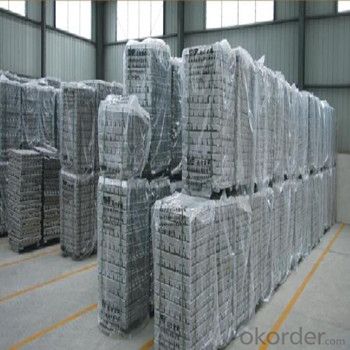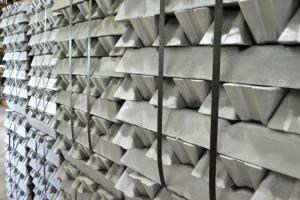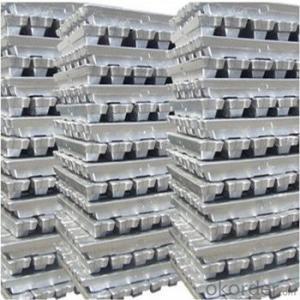Aluminium Ingot Pure 99.7% With High Quality National Standard
- Loading Port:
- China main port
- Payment Terms:
- TT OR LC
- Min Order Qty:
- 1000 m.t.
- Supply Capability:
- 10000 m.t./month
OKorder Service Pledge
OKorder Financial Service
You Might Also Like
Pure Aluminum Ingot Used for Industry
1.Structure of Aluminum Ingot Description
A material that has been cast into a shape in order to be transported and processed easier than in an unprocessed form. An ingot is typically rectangular in shape, which allows it to be stacked. Ingots are most commonly associated with metals, with ingots of gold held in the vaults of banks and brokerages being popular images.
.
2.Main Features of the Aluminum Ingot
•High Purity
•Easy operation
•High strength
•Fast melting
•Competitive price
•Best Service
3. Aluminum Ingot Images


4. Aluminum Ingot Specification
Grade | Chemical Composition % | |||||||||
Al≥ | impurities ≤ | |||||||||
Si | Fe | Cu | Ga | Mg | Zn | Mn | others | Sum | ||
Al99.9 | 99.90 | 0.50 | 0.07 | 0.005 | 0.02 | 0.01 | 0.025 | - | 0.010 | 0.10 |
Al99.85 | 99.85 | 0.80 | 0.12 | 0.005 | 0.03 | 0.02 | 0.030 | - | 0.015 | 0.15 |
Al99.7 | 99.70 | 0.10 | 0.20 | 0.010 | 0.03 | 0.02 | 0.030 | - | 0.030 | 0.30 |
Al99.6 | 99.60 | 0.16 | 0.25 | 0.010 | 0.03 | 0.03 | 0.030 | - | 0.030 | 0.40 |
Al99.5 | 99.50 | 0.22 | 0.30 | 0.020 | 0.03 | 0.05 | 0.050 | - | 0.030 | 0.50 |
Al99.00 | 99.00 | 0.42 | 0.50 | 0.020 | 0.03 | 0.05 | 0.050 | - | 0.050 | 1.00 |
5.FAQ of Aluminum Ingot
We have organized several common questions for our clients,may help you sincerely:
①How about your company?
A world class manufacturer & supplier of castings forging in carbon steel and alloy steel,is one of the large-scale professional investment casting production bases in China,consisting of both casting foundry forging and machining factory. Annually more than 8000 tons Precision casting and forging parts are exported to markets in Europe,America and Japan. OEM casting and forging service available according to customer’s requirements.
②How to guarantee the quality of the products?
We have established the international advanced quality management system,every link from raw material to final product we have strict quality test;We resolutely put an end to unqualified products flowing into the market. At the same time, we will provide necessary follow-up service assurance.
③How long can we receive the product after purchase?
In the purchase of product within three working days, We will arrange the factory delivery as soon as possible. The pecific time of receiving is related to the state and position of customers.Commonly 7 to 10 working days can be served.
- Q: What are the different forms of aluminum ingots available in the market?
- There are several different forms of aluminum ingots available in the market, including standard ingots, T-ingots, sow ingots, and rolled ingots.
- Q: What are the dimensions of a typical aluminum ingot?
- The dimensions of a typical aluminum ingot can vary depending on the specific industry and application. However, a commonly used standard size for aluminum ingots is approximately 20 inches (50 centimeters) long, 6 inches (15 centimeters) wide, and 2 inches (5 centimeters) thick. These dimensions are not fixed and can be adjusted based on the requirements of the customer or the specific production process. Additionally, there are various other sizes and shapes of aluminum ingots available in the market, ranging from smaller sizes used for specialized applications to larger ingots used for industrial purposes.
- Q: What are the advantages of using aluminum ingots in the production of medical devices?
- There are several advantages to using aluminum ingots in the production of medical devices. Firstly, aluminum is a lightweight material, which makes it easier to handle and transport the devices. This is particularly beneficial for medical devices that need to be portable or used by patients on a regular basis. Secondly, aluminum has excellent corrosion resistance properties. Medical devices often come in contact with various fluids and substances, and using aluminum ensures that the devices will remain durable and unaffected by these interactions. This prolongs the lifespan of the devices and reduces the need for frequent replacements. Additionally, aluminum is a highly malleable material, allowing for intricate designs and customization of medical devices. This enables manufacturers to create devices that fit specific patient needs and requirements, resulting in better overall performance and patient comfort. Furthermore, aluminum is a cost-effective material compared to other metals commonly used in medical device production. Its abundance and relatively low production costs make it a more affordable option, which can help reduce the overall cost of medical devices and make them more accessible to patients. Overall, the advantages of using aluminum ingots in the production of medical devices include lightweight nature, corrosion resistance, malleability, and cost-effectiveness, all of which contribute to improved functionality, durability, and affordability of these devices.
- Q: How much does it cost to process the aluminum ingots into T5-6063 models? Now, what about costing the aluminum ingot or the aluminum bar?
- T6 is artificially aged by solid solution heat treatmentIt is suitable for the products which are treated by solid solution heat treatment, no longer cold processing (can be straightened and leveling, but does not affect the mechanical performance limit)
- Q: How are aluminum ingots tested for quality?
- To ensure compliance with required standards, aluminum ingots undergo a rigorous series of quality tests. These tests encompass multiple procedures, including visual examination, mechanical analysis, chemical assessment, density and hardness measurements, and non-destructive testing. The visual inspection is a fundamental examination of the ingots' external appearance. Inspectors meticulously scrutinize the surface for any signs of defects, such as cracks, dents, or irregularities. This evaluation serves as an indicator of the ingots' overall quality and integrity. Mechanical tests are then conducted to gauge the strength and durability of the aluminum ingots. Among these tests, tensile strength assessments are performed to determine the maximum stress the ingots can endure before fracturing. These evaluations provide crucial insights into the ingots' structural soundness and resistance to external forces. Chemical analysis constitutes another pivotal aspect of the quality testing process for aluminum ingots. It involves identifying the metal's chemical composition and purity. To accomplish this, samples are extracted from the ingots and subjected to techniques such as spectroscopy or mass spectrometry. These methods aid in uncovering the presence of any impurities or elements that might impact the aluminum's quality. The density and hardness of the ingots are also measured to ensure compliance with specified criteria. Density assessments aid in determining the consistency of the molten metal during the casting process. Hardness tests, on the other hand, shed light on the ingots' strength and resistance. Furthermore, non-destructive testing methods, such as ultrasonic testing or X-ray inspection, are employed to detect any concealed flaws or inconsistencies within the ingots. These techniques are invaluable in identifying internal defects that could compromise the quality of the aluminum. In conclusion, aluminum ingots undergo a comprehensive testing process encompassing visual inspection, mechanical analysis, chemical assessment, density and hardness measurements, and non-destructive testing. These meticulous tests guarantee that the ingots satisfy the necessary quality standards, rendering them suitable for further utilization across diverse industries.
- Q: What is the melting point of aluminum ingots?
- The melting point of aluminum ingots is approximately 660 degrees Celsius or 1220 degrees Fahrenheit.
- Q: What are the different surface treatments for aluminum ingots?
- Depending on the desired outcome and application, there are various surface treatments available for aluminum ingots. Some commonly used treatments include: 1. Anodizing: By creating a protective oxide layer, anodizing offers corrosion resistance, durability, and improved aesthetic appearance. 2. Powder coating: This treatment involves applying a dry powder to the ingot's surface, which is then cured under heat to form a protective and decorative coating. It provides excellent resistance to corrosion, fading, scratching, and offers a wide range of color options. 3. Polishing: Achieved through mechanical buffing, polishing creates a smooth and glossy finish. It enhances the appearance and improves corrosion resistance. 4. Brushing: This treatment utilizes abrasive brushes to create a textured or brushed finish, often for decorative or industrial purposes. It also provides corrosion resistance. 5. Chemical etching: By selectively removing material from the surface, chemical etching can create intricate patterns, logos, or text. It is suitable for branding or decorative purposes. 6. Clear coat: Applying a clear coat adds an extra layer of protection against corrosion while preserving the natural appearance of the metal. Clear coats often contain additives that enhance longevity. To determine the most suitable surface treatment for aluminum ingots, it is important to consider the specific requirements of the application and seek advice from professionals in the field.
- Q: What are the different methods for machining aluminum ingots?
- There are several different methods for machining aluminum ingots, including CNC milling, turning, drilling, grinding, and sawing. These methods allow for the precise shaping, cutting, and finishing of aluminum ingots to create various components and products.
- Q: What are the different testing methods for aluminum ingots?
- There are several testing methods employed to evaluate the quality and characteristics of aluminum ingots. Some of the common testing methods for aluminum ingots include: 1. Chemical Analysis: This method involves analyzing the chemical composition of the aluminum ingot to determine the presence and quantity of various elements. It helps in ensuring that the ingot meets the required specifications and standards. 2. Tensile Testing: Tensile testing is used to assess the mechanical properties of aluminum ingots. It measures the ingot's ability to withstand tension and determines its ultimate tensile strength, yield strength, and elongation. 3. Hardness Testing: Hardness testing measures the resistance of an aluminum ingot to deformation or indentation. Various methods like Brinell, Rockwell, and Vickers hardness tests can be used to determine the hardness of the ingot. 4. Ultrasonic Testing: Ultrasonic testing utilizes high-frequency sound waves to detect internal defects such as cracks, voids, or inclusions in aluminum ingots. This non-destructive testing method helps in ensuring the structural integrity of the ingot. 5. Visual Inspection: Visual inspection involves carefully examining the surface of aluminum ingots to identify any visible defects, such as cracks, pits, or surface irregularities. This method is often the first step in the testing process and provides valuable insights into the overall quality of the ingot. 6. Dimensional Inspection: Dimensional inspection checks the physical dimensions and tolerances of aluminum ingots. This includes measuring the length, width, thickness, and any other critical dimensions to ensure they meet the required specifications. 7. Microstructural Analysis: Microstructural analysis involves examining the microscopic structure of aluminum ingots using techniques like metallography and optical microscopy. It helps to assess the ingot's grain size, distribution of phases, and identify any abnormalities or defects in the microstructure. 8. Impact Testing: Impact testing evaluates the behavior of aluminum ingots under high-stress conditions. It measures the ingot's resistance to sudden impact or shock loading and determines its toughness and ability to withstand sudden loads. These testing methods are crucial in ensuring the quality, integrity, and performance of aluminum ingots. By employing these tests, manufacturers can identify any flaws or defects and take appropriate measures to improve the overall quality of the ingots.
- Q: How are aluminum ingots used in the packaging industry?
- Aluminum ingots play a crucial role in the packaging industry due to their unique properties and versatility. These ingots are primarily used to manufacture various types of aluminum packaging materials such as cans, foils, containers, and lids. One of the primary uses of aluminum ingots in the packaging industry is for manufacturing aluminum cans. These cans are widely used for packaging beverages, including soft drinks, beer, and energy drinks. Aluminum cans are preferred over other materials due to their lightweight nature, which makes them easier to transport and stack. Additionally, aluminum cans provide excellent protection against light, oxygen, and moisture, ensuring the quality and freshness of the packaged product. Another common application of aluminum ingots in the packaging industry is for producing aluminum foils. Aluminum foils are used for wrapping food items, such as chocolates, snacks, and pre-cooked meals, as well as for sealing bottles and containers. The exceptional barrier properties of aluminum foils prevent the entry of air, moisture, and contaminants, thereby preserving the taste, texture, and overall quality of the packaged food. Aluminum ingots are also utilized in the manufacturing of aluminum containers, commonly known as trays or pans, which are extensively used for packaging ready-to-eat meals and takeout food. These containers are lightweight, durable, and can withstand high temperatures, making them suitable for both cooking and reheating. Additionally, aluminum ingots are employed in the production of aluminum lids and closures used in the packaging industry. These lids are designed to fit tightly on various packaging materials, ensuring the integrity and safety of the packaged products. Aluminum lids provide an effective seal, preventing leakage, contamination, and tampering. Overall, aluminum ingots are widely used in the packaging industry due to their excellent properties, including corrosion resistance, lightweight, and malleability. By utilizing aluminum ingots, the packaging industry can produce sustainable, durable, and high-quality packaging materials that meet the demands of modern consumers.
Send your message to us
Aluminium Ingot Pure 99.7% With High Quality National Standard
- Loading Port:
- China main port
- Payment Terms:
- TT OR LC
- Min Order Qty:
- 1000 m.t.
- Supply Capability:
- 10000 m.t./month
OKorder Service Pledge
OKorder Financial Service
Similar products
Hot products
Hot Searches
Related keywords


























